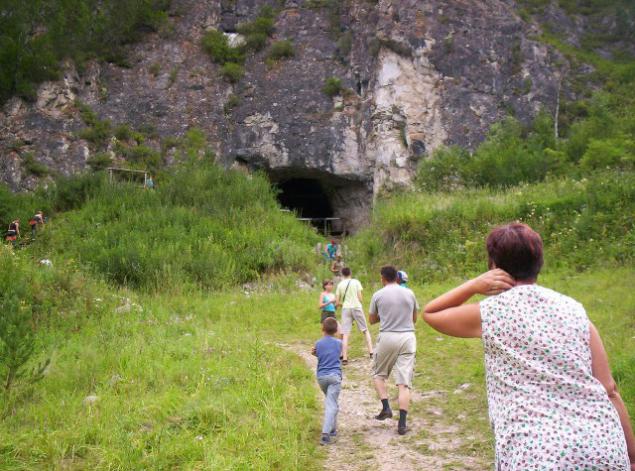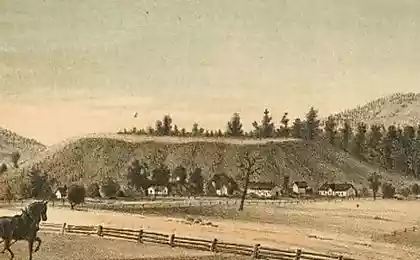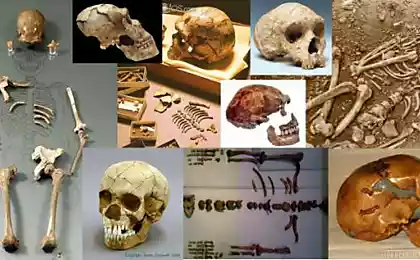778
5 amazing archaeological finds made on the territory of Russia
Most importantly, it was possible to go on raskopatRech finds made on the territory of our country.
Birch bark "No other church book you will not find that written in birch bark. It shows the everyday life of ordinary people "- says in his play" Farewell to paper "of the Novgorod birch bark Eugene Grishkovets. It is indeed the case. That birch bark archaeologists told about how our ancestors lived in those times (XI-XV centuries), how to communicate between themselves as loved and hated, what they ate and what they drank, and so on. D.

it believed that the first birch-bark scroll medieval Russia was found July 26, 1951 in Veliky Novgorod on the site of the so-called end Nerevskogo (residential area of ancient Novgorod). In reading and writing was scrawled list of feudal misdemeanors addressed some of Thomas.
A large number of birch-bark letters found in Staraya Russa, Smolensk, Pskov, Vitebsk, Mstislav, Tver. But most of the letters found still in Veliky Novgorod.
Birch bark was considered "inferior" material for writing. For a long time it is not stored, so it often used for private correspondence. Official same documents written on parchment.
Gnёzdovskie kurganyTak called complex of ancient monuments, burial mounds and settlements, which are located near the village on the banks of the Dnieper Gnezdovo 12 km west of Smolensk. It is considered one of the most significant archaeological monuments of culture of Smolensk long mounds, the largest burial mounds in Eastern and Northern Europe.

The mounds lie the rich warriors with all the belongings of military weapons, and ordinary citizens with their numerous household items. In Gnёzdovskih cemeteries found about a third of all detected in Eastern Europe Scandinavian pagan amulets, which are also called "Thor hammers».
Such a number of Scandinavian items IX-X centuries, speaks in favor of the fact that in those days the Vikings not only penetrated the middle reaches of the Dnieper, but also settled in these lands.
Denisovsky chelovekOstanki this fossil and the fourth type of humanity (the other three - in fact, Homo sapiens, Neanderthals and people from the island of Flores) in 2008 have been found in which later became famous Denisova Cave in the Altai group of archaeologists led by Anatoly Derevyanko. For more information about the four types of resources people to read in an interview with the famous Russian anthropologist Stanislaus Drobyshevsky.

Despite the fact that the remains denisovan were (and still are) extremely poor - only the phalanx of the little finger and a tooth - scientists were able to extract DNA from them. It was then revealed that the remains do not belong Homo sapiens, Neanderthals nor (nor, of course, floreseytsam who lived thousands of kilometers away on the isolated island of Flores), and the fourth, a new species of humanity. The results of DNA analysis showed that Denisovsky people like the Neanderthals, Cro-Magnons were mixed with. However, this applies only to Malays and natives of Australia: it is in their veins the blood of denisovtsev.
Old Ryazan klady
Old Ryazan - is not only one of the largest ancient cities, but also the largest archaeological site of ancient settlement in Russia today. Only the area of its urban fortifications is 60 hectares. City destroyed the Mongol invasion of Batu Khan (Batu Khan) in 1237. Over the next centuries, the peasants were digging Old Ryazan settlement and found many valuable items. Among them are preserved only those that have been found in the XIX century and later. One such remarkable findings became a farmer found the treasure in 1822, which is kept in the Armory Museum in Moscow. The treasure is the gold items with a total weight of 2 807 kg. The find is called "Ryazan barmas" (Mantle), and scientists are still arguing about the purpose of these decorations. However, the main value of the Ryazan barmas - a medallion with the image of Our Lady in a pose Orans (praying) Byzantine works.
Old Ryazan treasure also includes archaeologists unearthed the ruins of an ancient cathedral, stone sarcophagi, in which lie the remains of the Ryazan princes and princesses, the ruins of the Cathedral of Sts and other burial.
MangazeyaTakoe name wore Polar first Russian city of the XVII century. It originated in 1607 on the River Taz in Siberia. It was created in the first place, for the implementation of the government's control of the sea Mangazeysky course, connects the White Sea and the Ob. Through Mangazeya to Siberia carried flour, bread, salt and other goods, and took out a huge amount of fur. The city was rich, his wealth even composed legends, calling Mangazeya "zlatokipyaschey».

Alas, the city lasted less than a century - have left the Mangazeya. Important in this played a role in the overall change in the ways of colonization of Siberia, and more - the impoverishment of the local fur trade. Mangazeya became uninteresting for its citizens. But not for archaeologists. The first excavations in these places held in 1862 YI Kushelevskiy. The excavations revealed that Mangazeya was typical of ancient cities the division of the city (Kremlin) and planted.
via nked-science.ru/article/history/5-sudbonosnykh-arkheologichesk
Birch bark "No other church book you will not find that written in birch bark. It shows the everyday life of ordinary people "- says in his play" Farewell to paper "of the Novgorod birch bark Eugene Grishkovets. It is indeed the case. That birch bark archaeologists told about how our ancestors lived in those times (XI-XV centuries), how to communicate between themselves as loved and hated, what they ate and what they drank, and so on. D.

it believed that the first birch-bark scroll medieval Russia was found July 26, 1951 in Veliky Novgorod on the site of the so-called end Nerevskogo (residential area of ancient Novgorod). In reading and writing was scrawled list of feudal misdemeanors addressed some of Thomas.
A large number of birch-bark letters found in Staraya Russa, Smolensk, Pskov, Vitebsk, Mstislav, Tver. But most of the letters found still in Veliky Novgorod.
Birch bark was considered "inferior" material for writing. For a long time it is not stored, so it often used for private correspondence. Official same documents written on parchment.
Gnёzdovskie kurganyTak called complex of ancient monuments, burial mounds and settlements, which are located near the village on the banks of the Dnieper Gnezdovo 12 km west of Smolensk. It is considered one of the most significant archaeological monuments of culture of Smolensk long mounds, the largest burial mounds in Eastern and Northern Europe.

The mounds lie the rich warriors with all the belongings of military weapons, and ordinary citizens with their numerous household items. In Gnёzdovskih cemeteries found about a third of all detected in Eastern Europe Scandinavian pagan amulets, which are also called "Thor hammers».
Such a number of Scandinavian items IX-X centuries, speaks in favor of the fact that in those days the Vikings not only penetrated the middle reaches of the Dnieper, but also settled in these lands.
Denisovsky chelovekOstanki this fossil and the fourth type of humanity (the other three - in fact, Homo sapiens, Neanderthals and people from the island of Flores) in 2008 have been found in which later became famous Denisova Cave in the Altai group of archaeologists led by Anatoly Derevyanko. For more information about the four types of resources people to read in an interview with the famous Russian anthropologist Stanislaus Drobyshevsky.

Despite the fact that the remains denisovan were (and still are) extremely poor - only the phalanx of the little finger and a tooth - scientists were able to extract DNA from them. It was then revealed that the remains do not belong Homo sapiens, Neanderthals nor (nor, of course, floreseytsam who lived thousands of kilometers away on the isolated island of Flores), and the fourth, a new species of humanity. The results of DNA analysis showed that Denisovsky people like the Neanderthals, Cro-Magnons were mixed with. However, this applies only to Malays and natives of Australia: it is in their veins the blood of denisovtsev.
Old Ryazan klady

Old Ryazan - is not only one of the largest ancient cities, but also the largest archaeological site of ancient settlement in Russia today. Only the area of its urban fortifications is 60 hectares. City destroyed the Mongol invasion of Batu Khan (Batu Khan) in 1237. Over the next centuries, the peasants were digging Old Ryazan settlement and found many valuable items. Among them are preserved only those that have been found in the XIX century and later. One such remarkable findings became a farmer found the treasure in 1822, which is kept in the Armory Museum in Moscow. The treasure is the gold items with a total weight of 2 807 kg. The find is called "Ryazan barmas" (Mantle), and scientists are still arguing about the purpose of these decorations. However, the main value of the Ryazan barmas - a medallion with the image of Our Lady in a pose Orans (praying) Byzantine works.
Old Ryazan treasure also includes archaeologists unearthed the ruins of an ancient cathedral, stone sarcophagi, in which lie the remains of the Ryazan princes and princesses, the ruins of the Cathedral of Sts and other burial.
MangazeyaTakoe name wore Polar first Russian city of the XVII century. It originated in 1607 on the River Taz in Siberia. It was created in the first place, for the implementation of the government's control of the sea Mangazeysky course, connects the White Sea and the Ob. Through Mangazeya to Siberia carried flour, bread, salt and other goods, and took out a huge amount of fur. The city was rich, his wealth even composed legends, calling Mangazeya "zlatokipyaschey».

Alas, the city lasted less than a century - have left the Mangazeya. Important in this played a role in the overall change in the ways of colonization of Siberia, and more - the impoverishment of the local fur trade. Mangazeya became uninteresting for its citizens. But not for archaeologists. The first excavations in these places held in 1862 YI Kushelevskiy. The excavations revealed that Mangazeya was typical of ancient cities the division of the city (Kremlin) and planted.
via nked-science.ru/article/history/5-sudbonosnykh-arkheologichesk
10 facts about horror films, no less spectacular than the films themselves
"Fox Village": Zao - the sweetest place on earth























